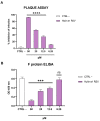Hylin-a1: A Pan-Inhibitor against Emerging and Re-Emerging Respiratory Viruses
- PMID: 37762191
- PMCID: PMC10531407
- DOI: 10.3390/ijms241813888
Hylin-a1: A Pan-Inhibitor against Emerging and Re-Emerging Respiratory Viruses
Abstract
Pandemic and epidemic outbreaks of respiratory viruses are a challenge for public health and social care system worldwide, leading to high mortality and morbidity among the human populations. In light of the limited efficacy of current vaccines and antiviral drugs against respiratory viral infections and the emergence and re-emergence of new viruses, novel broad-spectrum antiviral drugs are needed for the prevention and treatment of these infections. Antimicrobial peptides with an antiviral effect, also known as AVPs, have already been reported as potent inhibitors of viral infections by affecting different stages of the virus lifecycle. In the present study, we analyzed the activity of the AVP Hylin-a1, secreted by the frog Hypsiboas albopunctatus, against a wide range of respiratory viruses, including the coronaviruses HCoV-229E and SARS-CoV-2, measles virus, human parainfluenza virus type 3, and influenza virus H1N1. We report a significant inhibitory effect on infectivity in all the enveloped viruses, whereas there was a lack of activity against the naked coxsackievirus B3. Considering the enormous therapeutic potential of Hylin-a1, further experiments are required to elucidate its mechanism of action and to increase its stability by modifying the native sequence.
Keywords: SARS-CoV-2; antimicrobial peptide; coronavirus; emerging infection; influenza; inhibitory peptide; respiratory viruses.
Conflict of interest statement
The authors declare no conflict of interest.
Figures





References
-
- Wang X., Li Y., O’Brien K.L., Madhi S.A., Widdowson M.-A., Byass P., Omer S.B., Abbas Q., Ali A., Amu A., et al. Global burden of respiratory infections associated with seasonal influenza in children under 5 years in 2018: A systematic review and modelling study. Lancet Glob. Health. 2020;8:e497–e510. doi: 10.1016/s2214-109x(19)30545-5. - DOI - PMC - PubMed
-
- Blau D.M., Baillie V.L., Els T., Mahtab S., Mutevedzi P., Keita A.M., Kotloff K.L., Mehta A., Sow S.O., Tapia M.D., et al. Deaths Attributed to Respiratory Syncytial Virus in Young Children in High–Mortality Rate Settings: Report from Child Health and Mortality Prevention Surveillance (CHAMPS) Clin. Infect. Dis. 2021;73((Suppl. S3)):S218–S228. doi: 10.1093/cid/ciab509. - DOI - PMC - PubMed
MeSH terms
Substances
Grants and funding
- CUP B63C22001230002/Realizzazione di Servizi di Ricerca e Sviluppo per la Lotta contro il COVID-19"
- 2017M8R7N9/PRIN 2017 "Natural and pharmacological inhibition of the early phase of viral replication (Vir-SudNet)"
- PE00000007, INF-ACT/NextGeneration EU-MUR PNRR Extended Partnership initiative on Emerging Infectious Diseases
LinkOut - more resources
Full Text Sources
Medical
Miscellaneous

